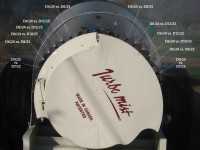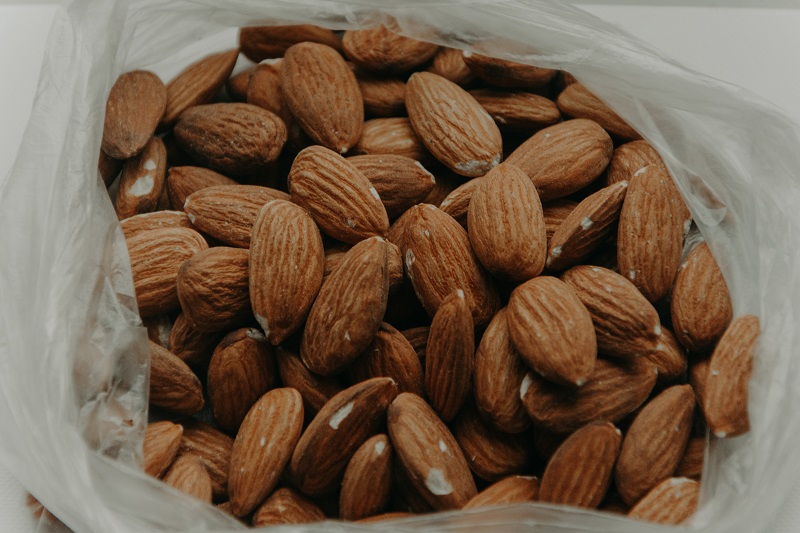“Gear Up and Throttle Down” With Your Sprayer

Between late fall and bloom is an important time for pest management in stone fruit orchards. Key pests like peach leaf curl, shot hole, peach twig borer, plum aphids, and scales can be very effectively managed in this wide treatment “window” — especially in the dormant or delayed dormant timing(s). A late fall spray can provide excellent plum aphid control for the entire next season. In these timings, especially after leaf fall, excellent coverage is relatively easily achieved and beneficial insects largely unharmed. No fruit is sprayed with a pesticide.
Unfortunately, there is a catch. The excellent spray coverage potential in the dormant/delayed dormant period also makes for a high spray drift risk. The lack of leaves in deciduous orchards at this time doesn’t effectively contain the air and pesticide mixture delivered by the sprayer. This article reports on recent spray research results in northern California stone fruit (prune) orchards in the late fall that may have application(s) in dormant timings in other stone fruit crops. This research was conducted by a research/Extension team led by Dr. Ken Giles, a professor in the University of California-Davis Ag and Biological Engineering Department, and Jim Markle from CURES (Coalition for Urban/Rural Environmental Stewardship).
This project began with a conversation with Bob McIntyre, sales manager for Slimline Manufacturing. Slimline builds TurboMist sprayers and is headquartered in Penticton, British Columbia. Bob introduced me to “Gear Up and Throttle Down,” a concept intended to save time and fuel during farm tractor use. Bob thought it ought to work for tractor-pulled orchard sprayers, too. “Gear Up and Throttle Down” isn’t a new idea; R.K. Koelsch, from Cornell University, published an Extension publication titled “Gear Up and Throttle Down to Save Fuel” in 1978. Robert Grisso, professor of biological systems engineering at Virginia Tech, has also written several Extension publications on this topic.
Dr. Andrew Landers, pesticide application technology specialist at Cornell University, has shown that spray drift can be reduced when engine (and PTO) speed is reduced with air shear (Kinkelder, etc.) sprayers. In 2010, at the time of our conversation, Bob McIntyre wasn’t aware of data from an orchard spray trial showing fuel and time savings plus drift and pest control results using “Gear Up and Throttle Down.”
The basic idea is that reducing engine speed will save money without harming the equipment or the quality of work delivered under light drawbar loads (less than 75% of full power) and flexible PTO speed conditions. With an appropriately sized airblast sprayer using a diaphragm pump or a centrifugal pump with variable PTO to pump power delivery (for example, the Rears Manufacturing pulley system) and an adequately powered tractor to deliver good coverage in season, it should be possible to reduce engine speed and PTO output and increase ground speed in commercial stone fruit orchards pruned and/or harvested by hand without harming pest control in the fall/dormant season when coverage is less of a challenge.
Think about it. Slow tractor speed (2 mph) and maximum fan air are very important to deliver the best possible coverage when the canopy is full. But, why use the same ground speed and sprayer set-up to spray a dormant or nearly dormant orchard, basically sticks, as you would use to spray that orchard with a preharvest fungicide when the canopy is most dense?
Testing The Concept
In the fall of 2010, we set out to take a close look at “Gear Up and Throttle Down” in a prune orchard in Sutter County, CA. A fall pesticide spray, properly applied, can control plum aphids for the entire season the following year. However, excellent coverage is required to make sure all aphids and aphid eggs are controlled — making a fall spray in prunes a perfect test system for the “Gear Up and Throttle Down” concept in stone fruit orchard spraying.
A demonstration spray drift/aphid control trial was established in a mature, 30-acre commercial orchard. The orchard layout is 15 feet between trees and 18 feet across the row. Tree height was about 15 feet. Leaf drop was not yet complete. The entire orchard, driving every row, was sprayed with original Warrior (lambda-cyhalothrin, Syngenta Crop Protection) at a rate of 3 ounces per acre from Nov. 12-18, 2010. A John Deere Model 5105ML tractor and a Slimline Manufacturing TurboMist S30P600S sprayer with a 600-gallon tank and diaphragm pump were used. Three tanks were sprayed using each treatment. Time of application and diesel used for spraying each tank were measured.
Two different sprayer set-ups were used. (The details appear in the table on this page.) Six nozzles per side of the sprayer, targeting the orchard canopy, were used. Larger nozzles were used in the “Gear Up and Throttle Down” set up to maintain 100 gpa calibration at the faster ground speed. In the grower standard treatments, nozzles ranged from TeeJet D4 to D6 with 25 cores. In the “Gear Up and Throttle Down,” TeeJet D7-D12 were used, again with 25 cores. (See photo on the opposite page for an illustration of this.) Larger nozzles make bigger spray drops. Coupled with reduced sprayer air flow, larger drops should reduce spray drift. To check differences in drift between the two treatments, fallout from the spray application was collected on two cellulose pads placed at 25, 50, 100, and 200 feet from the southern edge of the orchard.
Positive Results
The “Gear Up and Throttle Down” settings produced savings in time and fuel and reduced drift without changing the outcome of the grower standard spray. Diesel use was cut in half using the faster ground speed and lower tractor RPMs compared to the slow and hard approach.
Time in the orchard was reduced by one third. Using the “Gear Up and Throttle Down” settings, drift fall-out was a quarter of that from the grower standard settings at 25 feet outside the orchard. Similar reductions were measured at 50 feet and 75 feet using the “Gear Up and Throttle Down” approach. At 100 feet from the orchard, pesticide was not detected on the collectors when “Gear Up and Throttle Down” was used, while a low level of pesticide was detected after the grower standard set up was used. There was no aphid pressure the following season (2011) throughout the 30-acre block. While we did not leave a control in the orchard to ensure that there really was a pest to manage, cost/time savings and drift reduction were obtained with “Gear Up and Throttle Down” compared to the grower standard treatment.
The study was repeated in November 2011 in a nearby orchard with a history of heavy mealy plum aphid pressure. An untreated section was included in this test. All settings, treatments, and measurements were the same as in 2010, except drift was not measured. Similar savings in time and diesel were measured. Significant aphid colonies developed in the unsprayed trees, while the sprayed trees were clean.
What do these research results mean to stone fruit growers in general? In orchards where good pest management is achieved in season with the current spraying equipment, it may be worth considering testing a “Gear Up and Throttle Down” strategy against the established program in fall or winter sprays — prebloom — to cut costs, shorten spraying time, and cut down on spray drift. “Gear Up and Throttle Down” should not be used with every-other-row spraying and has not been tested at bloom spray timings or at any other time between bloom and harvest.










